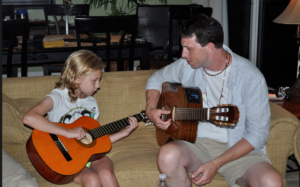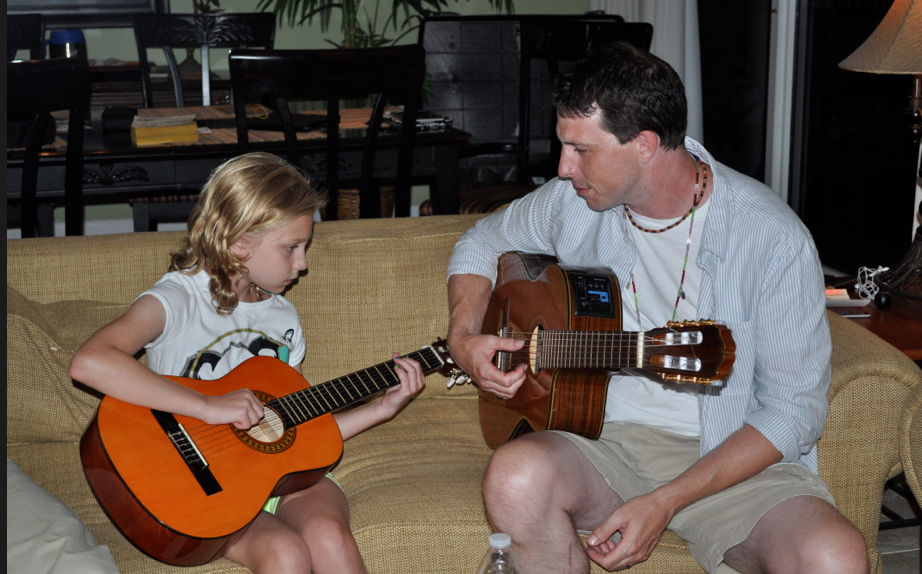 Ever wonder what actually goes on in a guitar lesson?
Ever wonder what actually goes on in a guitar lesson?
I’ve had lot of guitar lessons and I’ve also given thousands of them, probably 10’s of thousands.
On a one-on-one level, every student is different and so each lesson will be tailored to their levels, abilities and sensibilities. On a more general scale, there are certain things all guitar teachers are working with their students every week.
Different teachers present different styles, approaches and methods based on the way they play, their own experiences in music and their unique personality. It’s important that student and teacher be able to relate to each other, be able to communicate and have mutual respect and understanding about what is taking place. The goal is to learn to play the instrument but it should be enjoyable as well as challenging. The best teachers have a deep understanding for these values and practice them in their lessons.
Lessons usually run 30 minutes at most studios but some run on the 40 and 45 minute mark. Advanced and serious students should be taking at least an hour lesson every week. Daily practice should reflect a similar amount of time every day if not more to truly be successful. It takes time to learn an instrument. Time spent every day working things out as well as weeks, months and years of allowing the music to seep more deeply into our system.
As the Rolling Stones would say “Time is on my side” or our side as students and teachers. “Yes, it is!”
A regular lesson would follow certain routines based on the goals of the teacher and student. You might work differently if you are preparing for a recital than when you’ve just completed a performance. You 100th lesson will be different than your 1st one. While working the fundamentals is appropriate to all levels, more advanced students tend to get more mentoring or coaching vs. outright explanation.
Here’s a basic outline for a 30 minute lesson in our studio…
The student arrives (on time) and we greet each other. We make a little light conversation and see what’s happening in their lives this week. How have you been? How was that test? How was your trip? etc.
Then we Tune! A musician has got to be in tune and guitarists are always tuning.
Next we’ll do some physical warm-ups or exercises. We want to get the hands going, get all the engines firing together and address any stress or discomfort. We aim to find the easiest, tension-free approaches to playing the instrument. This is called good technique. We commit to it very early and in every lesson.
Then, we might work on sharpening our musical tools. This is usually in the form of working scales, chords, rhythms, ear-training, basic melodies and musicianship topics.
We spend a specific amount of time on each topic and we use a timer to keep us focused. A lesson is basically a guided practice session and is a great example for how the student should be working on their own.
We then work our sight-reading skills at the edge of the students reading ability. They work through specific method books to make them literate musicians. Music is a language and I want our students to be able to read it. I don’t force adult students to learn to read traditional notation though they will almost all learn to read tablature, chord symbols and basic rhythms.
Lastly, we work on specific pieces, tunes or songs. Our goal is to help the student build a repertoire that can be performed anywhere and anytime. If I meet a student 25 years down the road, I’ll expect that we can play some music together because we share possibly hundreds of pieces in our repertoire. Any one piece would take a focussed practice time of 2-20 minutes. Here we are mastering movements in music through perfect repetitions. This is not sight-reading. We identify problem areas and we set about doing the work to solve the problem.
Proper practicing is not easy and it doesn’t sound great. It sounds bad a lot of the time. We practice the things that are difficult for us. We stretch ourselves. Just playing what we can already play easily is not practice. That’s playing! And we should do lots of that too. Being able to play is the whole point. It’s the icing AND the cake. It’s what we’ve been working towards.
There isn’t any end to such work. Practice is the work. A lesson is personal time with a master teacher who can save you time, monitor progress, help you set goals, look out for your physical safety (physical damage to ligaments and tendons is very real and a lifelong affliction, tendonitis, carpal tunnel syndrome, etc.), motivate and inspire us.
Reviewing what has happened in each lesson is very important. This stuff all goes by very fast and we are super concentrated in the lesson. It can be easy to forget what we just did or what new thing we just learned. I always like to have the student re-iterate to me what we’ve done and what I expect them to work on in the coming week. I also write specific assignments into a daily assignment sheet that they can follow everyday during practice time.
Lessons are a real time and financial commitment. We work hard, we move quickly and we do our best in every moment. We are training our minds and bodies to perform, understand and appreciate one of our greatest human gifts. We share that gift with our students so they can share it with others. To me, that’s a blessing.
Thank you for letting us work with the musicians in your life.
Jason Riley
I’m a hustling musician and family man. I love to learn, play, share and encourage others in music. We’ve got some cool bands (including Soca Jukebox) and I am the director of the St. Joseph Arts Academy. This is my Blog!
http://www.jasonriley.com
https://stjosephartsacademy.com
http://www.socajukebox.com

